NRAO eNews
Volume Vol#, Issue Iss#
Day# Month# Year#
NRAO eNews
Volume Vol#, Issue Iss# • Day# Month# Year#

Upcoming Events

NRAO Town Hall
Jan 11, 2022 | Salt Lake City, UT

ALMA Special Session: ALMA Status & Plans for Increased Capability
Jan 13, 2022 | Salt Lake City, UT

ngVLA Special Session: Chemical Probes of Astrophysical Systems
Jan 13, 2022 | Salt Lake City, UT
NRAO / GBO Leadership Succession
It is my pleasure to announce that the NRAO has selected Dr. Patricia (Trish) Henning as the next Assistant Director for New Mexico Operations; and the Green Bank Observatory (GBO) has selected Dr. James M. Jackson as its next Director.
Assistant Director for New Mexico Operations
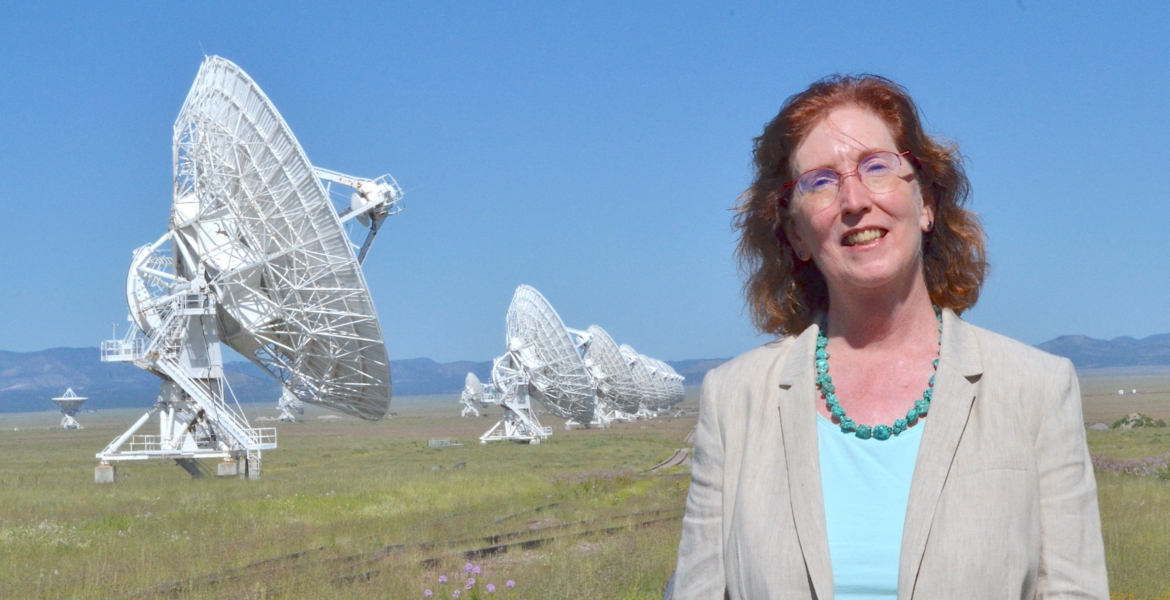
Dr. Patricia (Trish) Henning
[click to enlarge]
Effective 18 September, Dr. Patricia (Trish) Henning will lead the operations of the NRAO Karl G. Jansky Very Large Array (VLA), the Very Long Baseline Array (VLBA), and the Domenici Science Operations Center in Socorro, New Mexico. She currently is NRAO’s Assistant Director for Science Support and Research.
Dr. Henning joined NRAO in 2020 after a successful career as a researcher, educator, and administrator at the University of New Mexico (UNM). At UNM, she was Director of the Institute for Astrophysics, Head of User Programs for the Long Wavelength Array, Associate Chair of the Department of Physics and Astronomy, and Associate Vice President for Research. While serving in these roles, she also undertook a vigorous program of research using radio telescopes around the world, including the VLA.
Dr. Henning brings an impressive background as a scientist and a leader to her new role at NRAO. She is highly regarded by radio astronomers around the world and has extensive experience in using NRAO facilities as a research scientist. She also has an excellent background in science administration and management. She received her Ph.D. in astronomy at the University of Maryland, then held a postdoctoral appointment at the Netherlands Institute for Radio Astronomy in Dwingeloo, the Netherlands, before joining UNM in 1993.
Henning will succeed Dr. Mark McKinnon, who has served as the Assistant Director for New Mexico Operations since 2015. Over the past decade, Mark led the VLA and VLBA through significant technical upgrades while also serving as Project Director for the Next Generation Very Large Array (ngVLA) project.
Green Bank Observatory Director
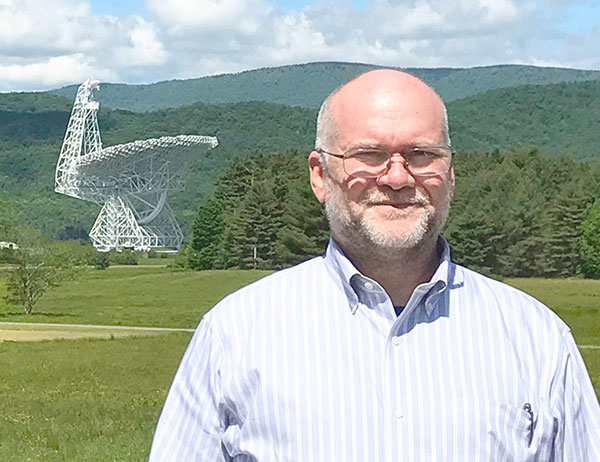
Dr. James M. Jackson
[click to enlarge]
The Green Bank Observatory (GBO) will enter a new era of leadership in mid-October, when Dr. James M. Jackson will become the GBO Director.
Dr. Jackson has served most recently as Associate Director for Research for the Stratospheric Observatory for Infrared Astronomy (SOFIA) with the Universities Space Research Association. He has also led administration and research in astronomy and astrophysics for the University of Newcastle (Australia) and Boston University, and served as Assistant Director for the Center for Astrophysical Research in Antarctica.
Dr. Jackson is a frequent user of the Green Bank Telescope (GBT). He is familiar with the site’s staff and resources, and the Observatory’s role as an essential facility in the nation’s astrophysics portfolio.
After serving as GBO Director for 15 years, Dr. Karen O’Neil will join the Observatory’s scientific staff. O’Neil has led the Observatory since 2006, including overseeing the separation from the NRAO and the successful transition to the Green Bank Observatory in 2016.
Please join me in welcoming Dr. Henning and Dr. Jackson to their new leadership roles at the NRAO and the GBO, respectively.
2022 Jansky Fellowship Program
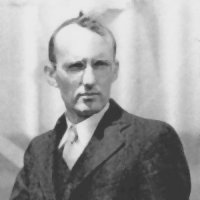
The Jansky Fellowship Program supports outstanding postdoctoral scientists and engineers whose research is broadly related to the mission of the National Radio Astronomy Observatory (NRAO). NRAO enables forefront research into the Universe at radio wavelengths. In partnership with the scientific community, we provide world-leading telescopes, instrumentation, and expertise, train the next generation of scientists and engineers, and promote astronomy to foster a more scientifically literate society. NRAO operates three world-class research facilities: the Atacama Large Millimeter/submillimeter Array, the Very Large Array, and the Very Long Baseline Array. We welcome applicants who bring innovative dimensions to the Observatory and to the field of radio astronomy.
As a Jansky Fellow, you will have a unique opportunity to contribute to and learn from the development and delivery of the largest and most capable radio telescopes in the world. Candidates with interests in radio astronomy techniques, multi-wavelength collaborations, instrumentation, computation, theory, and education/public outreach are encouraged to apply. Applicants should describe how their research or technical interests couple with NRAO’s mission, telescopes or science.
Appointments may be made at either of the NRAO sites: Socorro, NM, or Charlottesville, VA. In some cases, a ‘split appointment’ Jansky Fellowship split between a university and an NRAO site, or a ‘non-resident’ Jansky Fellowship hosted at a university within the United States may be offered. Regardless of appointment type, remote work arrangements may also be considered to accommodate limitations due to COVID-19. Non-resident Jansky Fellows are encouraged to develop a research program that fosters close ties with the NRAO, and should present a strong case why residence at their proposed host university will accomplish this. They are also strongly encouraged to make frequent and/or long-term visits to NRAO sites during their Fellowship.
All Jansky Fellows are expected to spend at least 75% of their time on self-directed research. Jansky Fellows also have the opportunity to spend 10-25% of their Fellowship engaging with Observatory staff on activities related to the development and delivery of radio astronomy techniques, capabilities, or education/public outreach activities, to develop their own broad skill set and enhance NRAO’s broader impact goals.
The NRAO Jansky Fellowship Program provides numerous opportunities for early career scientists and engineers to acquire a deep knowledge and understanding of the state-of-the-art in radio astronomy science and instrumentation to establish themselves as innovative, independent research scientists and engineers. Jansky Fellows are encouraged to develop research collaborations with NRAO scientific staff, scientists at U.S. universities, and their colleagues in the international astronomical or instrumentation community. An annual, multi-day NRAO Postdoctoral Symposium fosters collaboration between Jansky Fellows and the Observatory’s scientific staff.
The starting salary for the 2022 Jansky Fellowship program will be $70,500 for an initial two-year appointment with possible renewal for a third year. A research budget of up to $17,000 per year is provided for travel and computing support. Fellows are also eligible for page charge support, vacation accrual, health insurance, and a relocation allowance. NRAO can provide up to $3,000 per year to non-NRAO host institutions to defray local institutional expenses.
The deadline for 2022 Jansky Fellowship Program application materials, including letters of reference, is Monday, 1 November 2021 at 11:59 pm EDT.
Award offers will be made starting in early January 2022. Fellowships normally begin in September 2022.
More information about the Jansky Fellowship Program and instructions on how to apply, please visit https://science.nrao.edu/opportunities/postdoctoral-programs/jansky.
Questions or assistance with the application procedure, as well as requests for additional information on the Jansky Fellowship Program may be sent to Jansky2022@nrao.edu.
NRAO is an equal opportunity employer.
ngVLA Project News
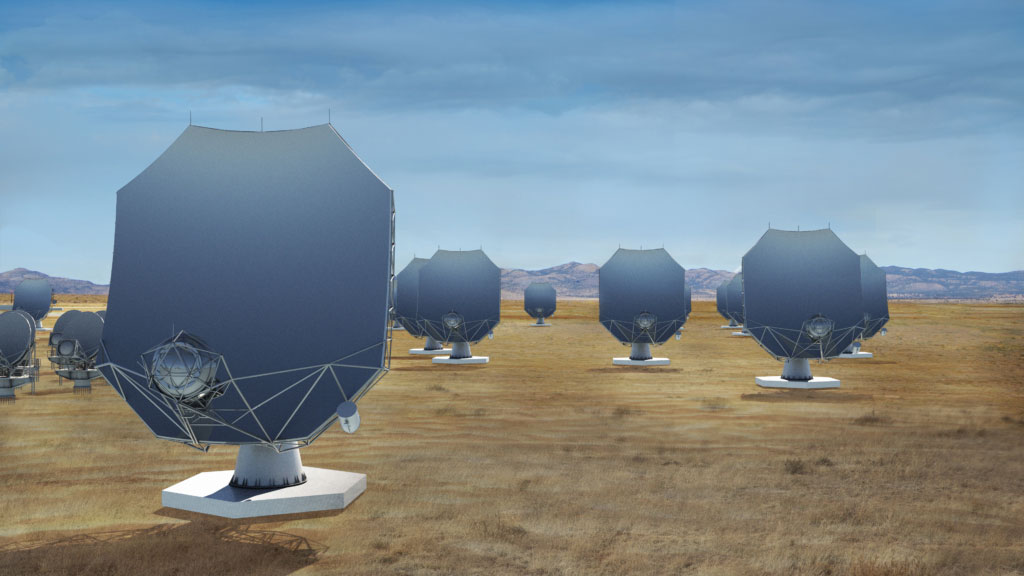
Sophia Dagnello, NRAO/AUI/NSF
Artist's conception of ngVLA antennas at the current site of the Karl G. Jansky Very Large Array on the Plains of San Agustin in west-central New Mexico.
[click to enlarge]
NSF Awards Funding for ngVLA Antenna Development
The U.S. National Science Foundation (NSF) has awarded the NRAO $23M USD for design and development work on the Next Generation Very Large Array (ngVLA), including producing a prototype antenna. The ngVLA, a powerful radio telescope with 263 dish antennas distributed across North America, is proposed as one of the next generation of cutting-edge astronomical observatories.
The ngVLA will include 244 antennas that are 18 meters (59 feet) in diameter, with an additional nineteen 6-meter (20-foot) dishes at the center of the system.
The ngVLA project currently is under review by the Astronomy and Astrophysics Decadal Survey (Astro2020) of the U.S. National Academy of Sciences. That report is expected soon. Following that report, the project will need approval by the NSF's National Science Board and funding by the U.S. Congress. Construction could begin by 2026, with early scientific observations starting in 2029, and full scientific operations by 2035.
On 27 May, NRAO officials signed an agreement with the firm mtex antenna technology Gmbh of Germany to develop a production-ready design and produce the prototype 18-meter antenna. Once built, the 18-meter prototype will be installed at the site of the Karl G. Jansky Very Large Array (VLA) in west-central New Mexico, where it will undergo extensive testing.
Building on the scientific and technical legacies of the VLA and the Atacama Large Millimeter/submillimeter Array (ALMA), the ngVLA will have sensitivity to detect faint objects and resolving power – ability to see fine detail – more than 10 times greater than the current VLA. It is being designed to address fundamental questions in all major areas of astrophysics and provide a major leap forward in our understanding of phenomena such as planets, galaxies, black holes, and the dynamic sky. The ngVLA's capabilities will complement those of ALMA and other planned instruments such as the lower-frequency Square Kilometre Array.
The ngVLA design is the result of extensive collaboration with researchers across the landscape of astrophysics. Through a series of workshops and science meetings beginning in 2015, NRAO worked with numerous scientists and engineers to develop a design that will support a wide breadth of scientific investigations over the lifetime of the facility. Participants from around the world contributed suggestions and expertise that helped guide the design.
See the NRAO press release for additional information.
ngVLA Special Session: Chemical Probes of Astrophysical Systems
The NRAO and the ngVLA project will convene a Special Session titled Chemical Probes of Astrophysical Systems on Thursday, 13 January 2022, at the winter American Astronomical Society (AAS) meeting.
This Special Session will highlight recent scientific breakthroughs in astrochemistry. It will feature a session of invited oral presentations, plus an associated poster session with contributed presentations. Please consider contributing to that poster session. When submitting a contributed poster abstract to the AAS, you will have the option of requesting that your presentation be included in this Special Session. Special Session presenters are also eligible to present elsewhere at the meeting.
Neutron Star Jets
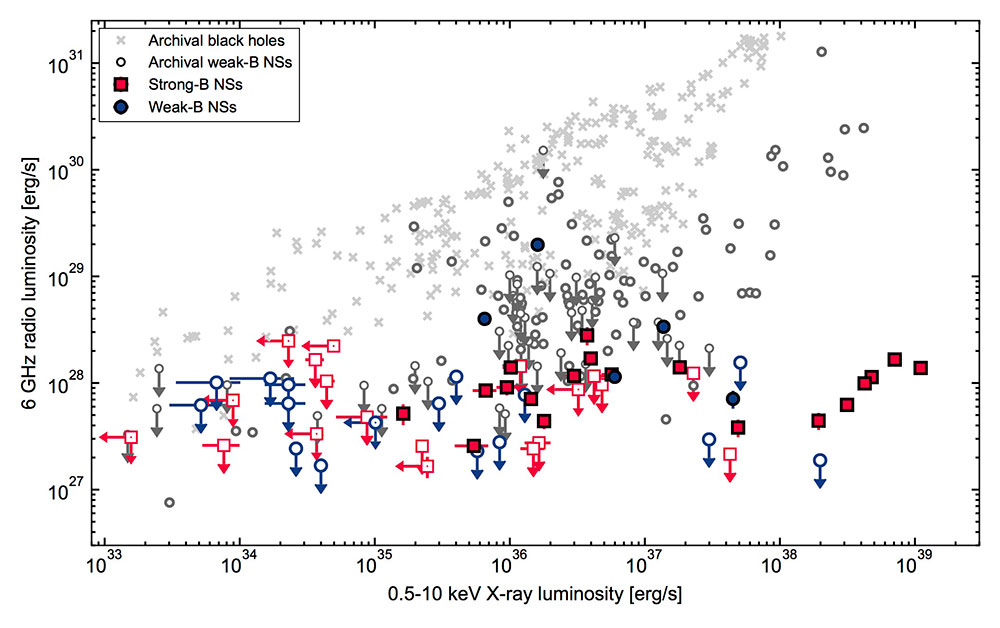
Relation between X-ray luminosity, probing the inflow of matter, and radio luminosity, tracking the relativistic jet. Colored points are the newly-observed accreting neutron stars, more than doubling the number of such targets observed at current radio sensitivity (Van den Eijnden et al. 2021).
[click to enlarge]
The accretion of matter is a ubiquitous process in the Universe, taking place across a wide variety of astronomical sources: from forming stars and planets, to stellar binaries, and active galactic nuclei. This accretion process typically leads to the formation of outflows, for instance in the form of relativistic, collimated jets, launched from the inner accretion flow.
To study matter inflow and outflow, and especially their connection, we often turn to X-ray binaries, where either a neutron star or a black hole accretes matter from a stellar donor in a tight orbit. X-ray binaries can change their accretion rate by orders of magnitude on time scales of weeks to months, making them particularly convenient targets to study changing radio jets (Fender et al. 2004). Our team is especially interested in accreting neutron stars and the effect that their magnetic fields and spin may have on jet formation.
Studying neutron star jets comes with a challenge, however: their radio luminosities are, on average, more than 20X fainter than their stellar-mass black hole counterparts (Gallo et al. 2018). Thus, a relatively small fraction of neutron star X-ray binaries has been detected at radio wavelengths (Migliari & Fender 2006), and this number is even more limited at low accretion rates. In our recent work (Van den Eijnden et al. 2021), we set out to extend this sample with VLA and Australia Telescope Compact Array observations taken between 2013 and 2020. Observing thirty-six neutron stars, we more than double the number of targets observed at current-day sensitivity. For the first time, we also report radio counterparts to neutron stars accreting persistently from high-mass donor stars, although we cannot unambiguously associate this emission with jets; instead, emission from the massive donor star's wind (Wright et al. 1975), or shocks in this wind induced by the neutron star, may also play a role.
The figure shows a fundamental tool in the radio study of X-ray binaries: the X-ray–radio luminosity diagram. The black hole, as well as weakly-magnetized (B < 1010 G) neutron star systems, show a global correlation between these two luminosities, highlighting the coupling between the inflows and outflows probed by these observing bands. The strongly-magnetized neutron stars (B > 1012 G, which predominantly orbit massive donor stars), on the other hand, do not yet reveal such a correlation, although this conclusion is strongly affected by their radio faintness: those with radio detections currently span only roughly an order of magnitude in radio luminosity.
The radio faintness of accreting neutron stars, especially with strong magnetic fields, is where the ngVLA can bring significant improvement: its sensitivity, compared to current arrays, will allow us to detect counterparts to a greater number of accreting neutron stars, in particular at low accretion rates. Hence, the ngVLA can reveal whether strongly-magnetized neutron stars also show coupled X-ray and radio behavior, currently undetectable due to sensitivity constraints. In addition, it would bring systems in close-by galaxies within sensitivity limits. Finally, combining the ngVLA sensitivity with sub-milli-arcsecond resolution, we can constrain brightness temperatures of high-mass X-ray binaries to distinguish between jet and stellar wind scenarios, as well as attempt to resolve jet ejections for close-by sources.
Since 2015 the acronym ngVLA has appeared in 700+ publications indexed in the SAO/NASA Astrophysics Data System. This article continues a regular feature intended to showcase some of those publications. We are especially interested in showcasing work done by early-career researchers. The collection of showcase articles can be viewed online. Anyone wishing to volunteer to author a feature should contact Joan Wrobel.
ALMA Ambassadors Program for Cycle 9
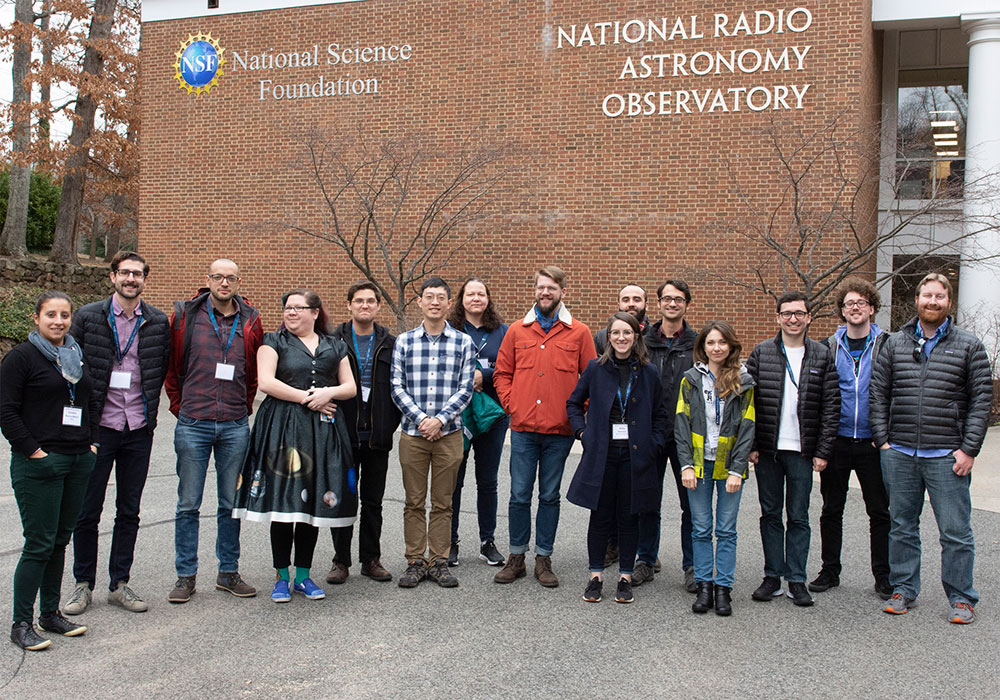
2020 ALMA Ambassadors during their training in February 2020 at the NRAO headquarters in Charlottesville, VA.
[click to enlarge]
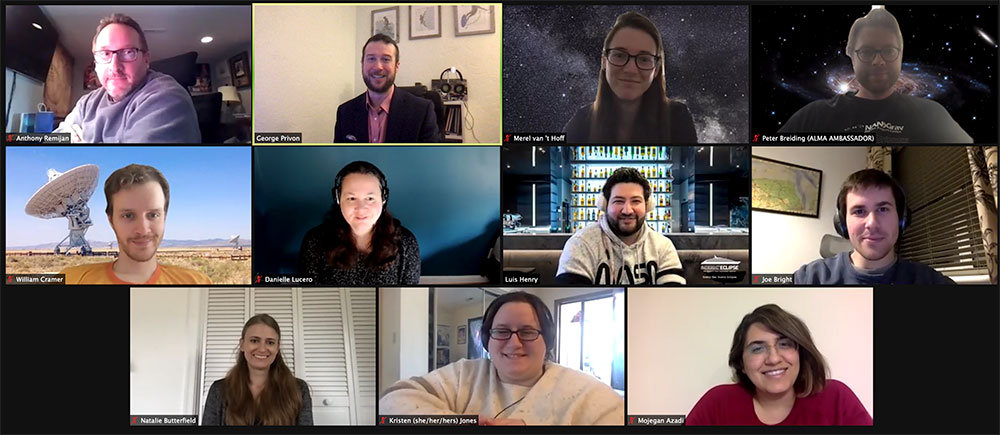
Cycle 8 2021 ALMA Ambassadors during their virtual training in February 2021.
[click to enlarge]
The North American ALMA Science Center (NAASC) is accepting applications for the ALMA Ambassadors Program. The program provides training and up to a $10,000 USD research grant (other forms of payment are available, see below) to postdoctoral researchers, senior graduate students, and early career researchers interested in expanding their ALMA/radio interferometry expertise and sharing that knowledge with their home (or other) institutions. For Cycle 9, ALMA Ambassadors can choose to support the community by organizing and hosting either:
The NAASC will host the selected Ambassadors at the National Radio Astronomy Observatory headquarters in Charlottesville, Virginia the week of 14 February 2022 to receive in-depth training. Training will include topics related to ALMA proposal writing, including: interferometry basics, ALMA science capabilities, recent ALMA headlines, use of the ALMA Observing Tool, and guidance for speaking on these topics. The training also includes a poster session where ALMA Ambassadors will showcase their own science to their fellow ambassadors and the local astronomical community, including NRAO staff. Ambassadors must host a proposal preparation workshop in advance of the Cycle 9 ALMA proposal deadline in April 2022 or data analysis and processing workshops. These workshops may be held at the ambassador's home institute, an alternate location, or virtually. ALMA Ambassadors will also make themselves available to help their local community between the call for proposals and the deadline and support other NAASC activities.
The NAASC will provide travel support for the training as well as all talk materials, supplies, and infrastructure for the workshops hosted by the ALMA Ambassadors. Up to a $10,000 monetary grant is offered in support of the selected ambassadors independent research programs (other grant forms are available, depending on eligibility). Some radio or submillimeter interferometry experience is preferred but not required. Applicants must be based at a North American institution. If you do not meet these requirements but are interested in learning more about the training we are offering, please contact George Privon to discuss opportunities. Although not required, we will consider multiple applicants from the same institution or region.
The deadline to apply is 15 October 2021. For more information, please visit the ALMA Ambassadors website.
Erratum: The application deadline has been extended to 27 October 2021.
ALMA Program News
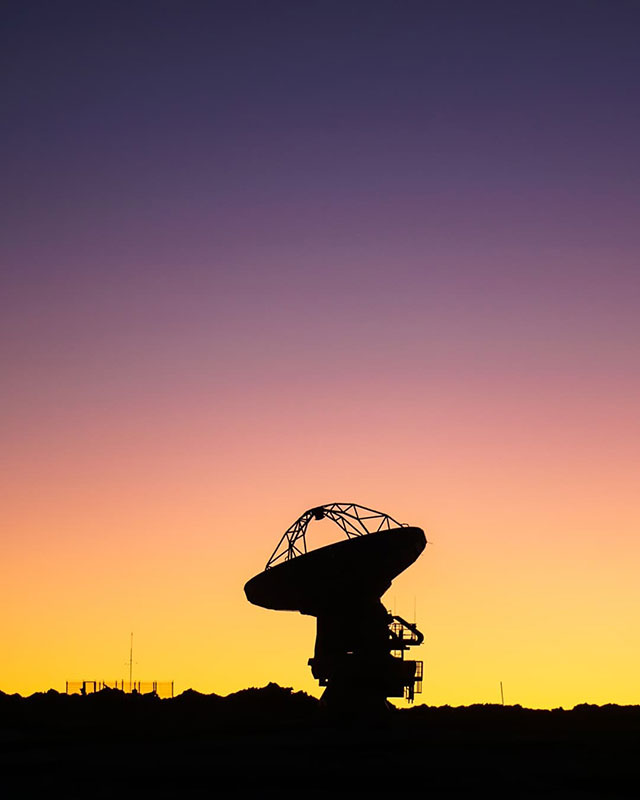
Pablo Carrillo
The Sun sets on an ALMA antenna.
[click to enlarge]
Cycle 8 2021 ALMA Proposals and ACA Supplemental Call
Results of the Cycle 8 2021 proposal review were sent to proposers in early August. A Detailed Report is available. The Joint ALMA Observatory (JAO) notified Principal Investigators (PIs) the results of the Cycle 8 2021 Call for Proposals, completing a process that began with the Cycle 8 pre-announcement last December. The proposal review process selected 253 high-priority programs (Grade A + B) that will be added to the observing queue when Cycle 8 observations start on 1 October.
The community submitted 1735 proposals that requested over 26,000 hours on the 12-m Array, far exceeding the time requested in previous cycles. With 4300 hours available on the 12-m Array, Cycle 8 was one of the most competitive cycles for ALMA time to date. The proposal review process had unprecedented participation by the community. Between the introduction of distributed peer review and the continuation of panel reviews for the larger proposals, over 1000 people participated in the virtual review process to help determine the Cycle 8 observing program. That program will begin 1 October 2021 with the array scheduled to be in its C43-8 configuration.
The JAO is conducting a detailed analysis of the results to identify any potential biases and is carefully considering the feedback from reviewers and PIs. In the coming months, a detailed analysis of the distributed peer review process will be made available.
ACA Supplemental Call
An Atacama Compact Array (ACA) Supplemental Call for Proposals in ACA stand-alone mode is scheduled for release 8 September 2021, along with the opening of the archive for submission of supplemental call proposals. The deadline for the Cycle 8 2021 ACA Supplemental Call for Proposals will be 6 October 2021. The ALMA Regional Centers provide support to all ALMA users. If you have any questions, comments or concerns related to your projects or the situation at ALMA, please contact the ALMA Helpdesk.
Joint ALMA Observatory Commences Longest Baseline Cycle 7 Observations
The ALMA 12-m Array has transitioned to the longest Cycle 7 baseline array, a hybrid C43-9/10 configuration and ALMA continues Cycle 7 PI observations with both the Main and ACA Arrays. This hybrid C43-9/10 array meets the beam criteria for all C43-10 projects in the queue. Antenna relocation from the longest baseline configuration to more compact arrays will commence later in September. In this array, ALMA extends over an area approximately that enclosed by the Washington beltway.
The AIPS Software Package
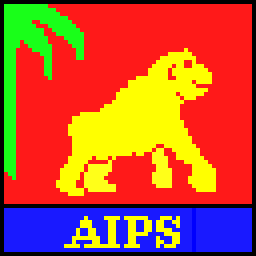
During the recent Very Large Array (VLA) 40th anniversary celebration, a number of positive comments were made about the Astronomical Image Processing System (AIPS) software package. In 1980, a VAX 11/780 was delivered to the VLA from Charlottesville in 1980 with a copy of the Radio Astronomy Numerical Computation and Imaging Device (RANCID), the software package name that had been adopted for political purposes, but was changed when NRAO Director Mort Roberts had to explain to the Associated Universities trustees the expenditure of $1M (1980) on the project hardware.
The AIPS package used an AP120B array processor to achieve an ~100X speed improvement in imaging algorithms, such as self-calibration and Clean. AIPS was written to be portable between computer systems, so it enabled VLA users to do some or all of their post-processing at their home sites even if they did not have an array processor. Users still had to visit the VLA to take their data and start on the data reduction, but AIPS allowed a reduction in the immense pressure on NRAO's computing facilities.
The early years of AIPS development are well-described in the Barry Clark Symposium volume titled Radio Interferometry: The Saga and the Science (1998) which is reproduced in AIPS Memo 100.
While this history is interesting, AIPS remains today a viable, mature software system. The current development version is called 31DEC21 and is available online. This website also provides access to much documentation, including the now semi-annual AIPSLetter, the Memo series, the CookBook, a detailed guide to the installation script, and much more.
During 2020, when most had to retreat to their homes and work remotely, the shipping numbers for AIPS went up, presumably because people were installing it on their home computers. However, the shipping numbers this year are considerably reduced. I suspect that many users have installed AIPS 31DEC20 at some time and then neglected to update it as it changed through the rest of 2020. A process called the "Midnight Job (MNJ)"–the preparation for it runs at midnight Charlottesville time–updates AIPS quite simply. It is installed in the user's home directory called do_daily.hostname. The MNJ should also be run in 2021 to update 31DEC20 for patches made to correct serious errors. Of course, installing 31DEC21 is recommended for its numerous improvements.
The 31DEC20 release features new tasks to compute and plot statistics of visibility data (UVRMS, SPRMS, RIRMS), improvements to Zeeman analysis, and several other new tasks. A major bug in the task that solves for and corrects any right minus left delay error (RLDLY) was corrected. A major bug in the task that recomputes the projected baseline parameters (UVFIX) affecting B1950 coordinate data was repaired as was a more subtle error in the differential aberration correction. These were also made as patches to 31DEC19. The 31DEC21 development version had a bunch of changes made to make the use of the AIPS TV display over a VPN less onerous. The use of images as calibration source models was corrected and improved. The VLBA pipeline (VLBARUN) continued to be improved and a new VLBA pipeline designed to monitor RFI at the VLBA sites was developed. The task that “glues” spectral windows back together (VBGLU) was enhanced to allow different observing runs to be concatenated so that they may be imaged together. A serious bug in the solver for the bandpass shape (BPASS) was fixed and patched into 31DEC20. Numerous other improvements and fixes were made to these releases. I encourage you to update your AIPS to 31DEC21 or at least to run the MNJ on your current version.
NRAO Job Opportunities
The National Radio Astronomy Observatory (NRAO) is recruiting for an Assistant Director for Science Support & Research (AD/SSR). SSR is the Observatory-wide function supporting all scientific users of NRAO instruments, and coordinating the scientific research of the NRAO staff.
This is an opportunity for an experienced scientist, with a track record of management and leadership, to take on an influential role in the senior management team of one of the world’s leading observatories. The appointee will help shape the mode of delivery of data to a global community of astronomers (the Science-Ready Data Products (SRDP) project), and contribute to the definition and planning of the Next Generation VLA – envisaged to be an interferometric array with more than 10 times the sensitivity and spatial resolution of the current VLA and ALMA, operating at frequencies spanning ∼ 1.2 − 116 GHz with extended baselines reaching across North America. Depending on the qualifications of the appointee, the position may include the role of Chief Scientist for the Observatory as a whole.
The AD/SSR is responsible for managing time allocation and the proposal handling processes for the VLA and VLBA (which are operated by NRAO), and for the GBT (which is operated independently by the Green Bank Observatory). The AD/SSR is tasked with ensuring a uniform and effective interface for NRAO’s user communities across all their telescopes and taking account of the ALMA review process, which is the responsibility of the Joint ALMA Observatory. The AD/SSR manages staff responsible for common scientific services provided in support of our instruments, and coordinates outward-facing activities across all sites to minimize duplication and achieve optimal efficiency in support of all users of NRAO facilities.
For further information, including application instructions, visit the Associated Universities, Inc. Careers page: http://jobs.jobvite.com/nrao/jobs. Consideration of applications will begin October 1, 2021 and will continue until the position is filled.
The North American ALMA Regional Center (NA ARC) is recruiting for up to three scientific staff positions. NRAO staff scientists are expected to enable cutting-edge science by the community, help enhance the scientific impact of NRAO telescopes, contribute to the overall NRAO mission. NRAO scientist-track appointments entail 25% independent scientific research and 75% functional responsibilities.
Scientist (Open Rank): Up to two positions will be within the North American ALMA Science Center (NAASC), focused within the ALMA Telescope Interface and Diagnostics Group. This group is the NAASC technical liaison to the Joint ALMA Observatory (JAO) in Chile and is responsible for all ALMA telescope-facing activities. The successful candidate(s) will work closely with the Telescope Interface and Diagnostics Group, the JAO, and the NAASC data processing team on functional duties that could include technical investigation, reporting and tracking of data quality issues, contributing to the extension and optimization of ALMA’s capabilities, scientific support of ALMA development programs, technical support for ALMA observations, and supporting ALMA telescope operations in Chile.
Assistant Scientist: One position will be focused on supporting development of ALMA-related functionality for NRAO’s Science Ready Data Products (SRDP) Initiative. The SRDP project aims to facilitate science at radio wavelengths by delivering data products that are ready to use for scientific study by a wide range of astronomers, including non-experts in interferometry, thereby making radio astronomy more accessible to the broader astronomical community. The successful candidate will work with the SRDP Project Scientist and the SRDP Heuristics Team to define and prototype new features to be included in ALMA/NRAO data processing pipelines, CASA software package, and the NRAO archive.
For further information, including application instructions, visit the Associated Universities, Inc. Careers page. The deadline for receipt of applications is October 15, 2021.
Virtual VLA Tour: Partnerships with NASA
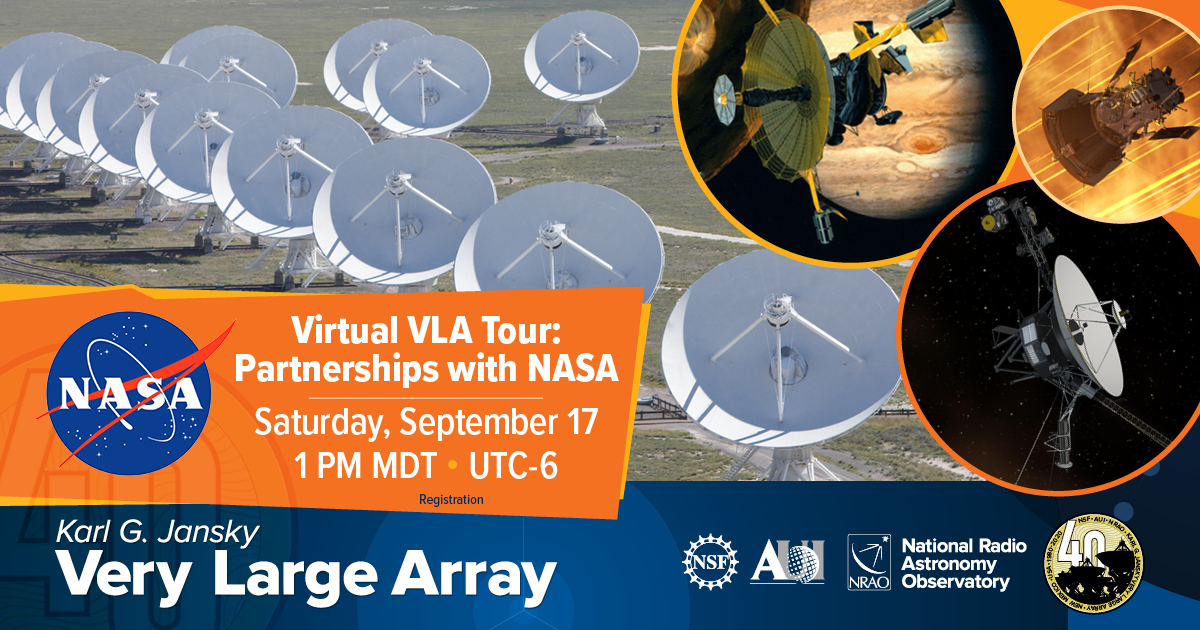
NRAO operates some of the most scientifically productive telescopes, but did you know that we occasionally partner with NASA to better understand our Solar System? The Very Large Array (VLA) has provided vital instrumentation for multiple NASA missions: from receiving the radio signal from NASA’s Voyager 2 spacecraft as it performed its Neptune flyby in 1989, to radar mapping the surface of Mercury in 1991 by detecting the reflected radio signal sent from NASA’s Goldstone antenna, a part of the Deep Space Network (DSN). Currently, the VLA is performing simultaneous observations of the Sun’s outer atmosphere with NASA’s Parker Solar Probe as its passes through the solar corona. Looking to the future, NRAO will play a role in NASA’s return to the Moon via the Artemis Program by developing a specialized radio receiver and high-frequency antennas for the Dark Ages Polarimetry Pathfinder (DAPPER) spacecraft, which will be put into low lunar orbit to search for faint radio signals from the early Universe.
Join us for a virtual tour followed by Q&A with several guest experts as we highlight some of our exciting partnerships with NASA.
The event will take place on Saturday, 18 September 2021, 1:00-2:30 PM Mountain Daylight Time (MDT, UTC/GMT–6).
This event will take place on Zoom. Registration is required.
NRAO Virtual Speaker Series

The NRAO is hosting a new Virtual Speaker Series titled From Cells to Galaxies – Exploring the Synergies between Radio Astronomy and Medical Imaging. This is a crossover series between medical imaging and radio interferometry that seeks to foster a dialogue / knowledge transfer between the two research communities and encourage collaboration opportunities. This series was originally scheduled to be held in-person in May 2020, but has been reorganized as a series of talks to be held virtually from September 2021–March 2022, and will be followed by a face-to-face event in Spring 2022.
Participants must register for the virtual presentation series. Registration is free at the series website.
Acknowledging Partners in Papers & Public Content
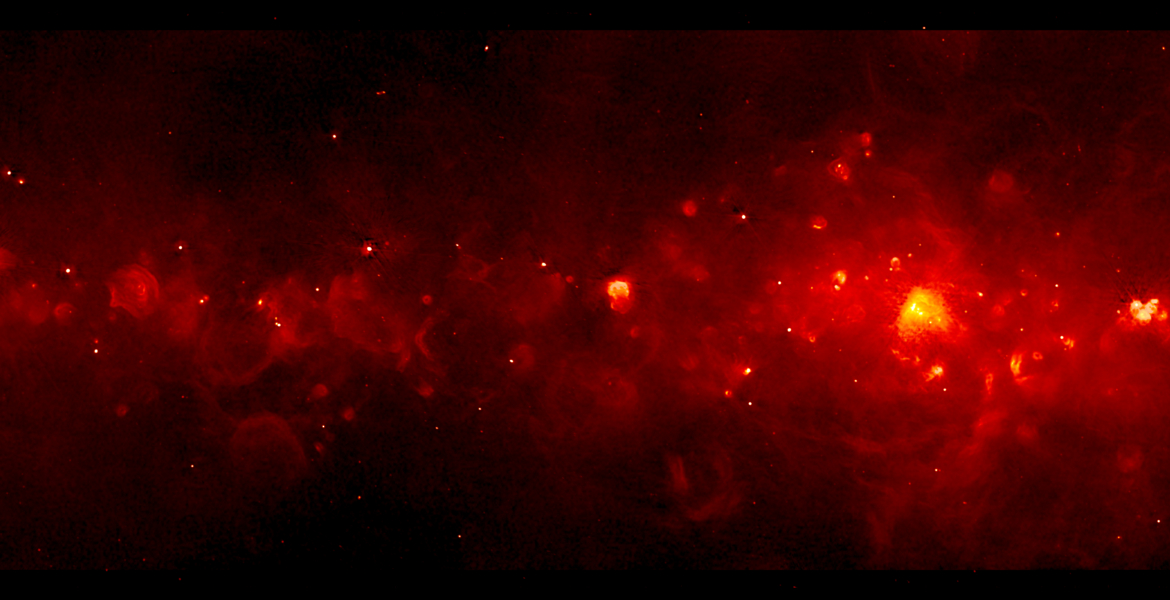
Brunthaler et al., Sophia Dagnello, NRAO/AUI/NSF
[click to enlarge]
Did you know that there are approved ways to acknowledge NRAO, CDL, ALMA, VLA, and VLBA?
If you are writing a scientific paper, press release, article, or other public content, you can reach out to our Public Information Officers (PIOs) for help in providing correct acknowledgments.
For NRAO, CDL, and ALMA, contact Amy C. Oliver.
For VLA and VLBA, contact Dave Finley.
Additionally, if you are a U.S. author writing a scientific paper, you may qualify for NRAO support on publication fees, if you meet the requirements. Check out the full list of requirements, including acknowledgments online, or visit the NRAO Library online for more information and a link to the Request for Support forms.
While the Astrophysical Journal goes Open Access in January 2022, eliminating subscription charges, that will result in an increase in author publication charges. So, learning to include to correct acknowledgements could benefit you in the long run.
Recent Media Releases
|
New Receivers Achieve First Light, Set Record for Observational Capabilities at ALMA |
|
|
Stellar Collision Triggers Supernova Explosion
|
|
|
NRAO Names New Assistant Director for New Mexico Operations |
|
|
Invisible Colors: Why Astronomers Use Different Radio Bands |
|
|
NSF Awards Funding for Next-Generation VLA Antenna Development |
From the Archives
Ellen Bouton

[click to enlarge]
About this month's photo: In late September 1976, with early Very Large Array construction happening outside, Barry Clark and Linda Blankenship [Sowinski] work at the site. Barry recalls that his terminal was a SuperBee, connected to the Modcomp real-time system, and that the terminal on the table to his left was connected to the Dec-10. Both were dumb terminals connected to rack-sized computers. Many computing changes since then! Thanks to Barry for caption info.
From the Archives is an ongoing series illustrating NRAO and U.S. radio astronomy history via images selected from our collections of individuals' and institutional papers. If readers have images they believe would be of interest to the Archives, please contact Ellen Bouton.

